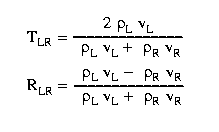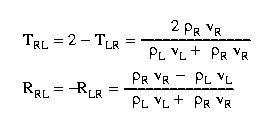A computer simulation (click to download)
An example of wave propagation on a string composed of two segments of different properties: the left with densityL = 1.0, velocityL = 3.0, and the right with densityR = 4.0, velocityR = 1.5. The arrow marks the position of the source (distance 6.5) which plucked the string at time 0. The vertical dashed line indicates the position of the junction. Both ends of the string are fixed.
 |
 |
The coefficients of reflection and transmission (shown above) depend not only on the string properties, but on the direction that the wave is travelling. As the wave travels from the right to the left, the density of the string decreases, and the velocity increases so that the reflection coefficient is strictly positive and the transmission coefficient is greater than 1. This means that the reflected wave will have the same sign as the incident, and that the transmitted wave will have an amplitude greater than the incident.
This animation illustrates several important facets of wave propagation:

|
|
|
|

|
|

|
|

|
|

|
Even though the example of the string is simple, the concepts it illustrates are used everyday by scientists and engineers. By examining seismic waves, we have learned much about the structure of the Earth. Oil and mining companies regularly use this technique to locate and exploit resources.

